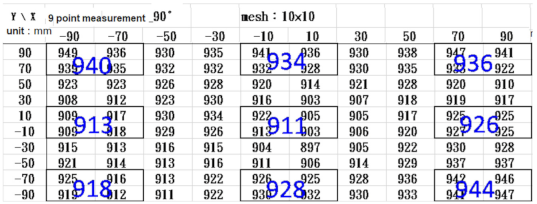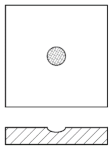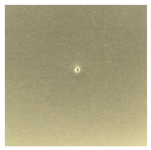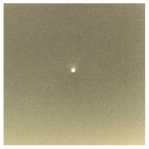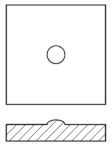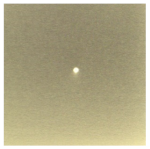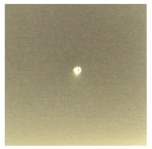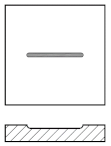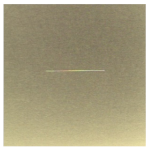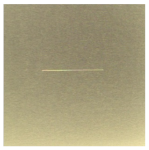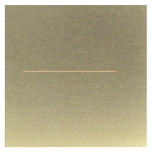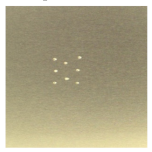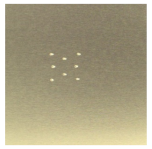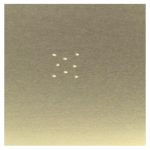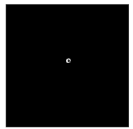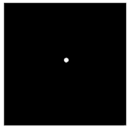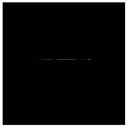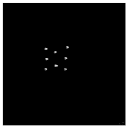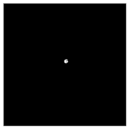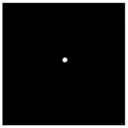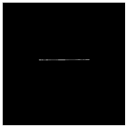Abstract
High strength and highly reflective metal sheets are widely applied in industry; industrial requirements for defect detection are extremely demanding, particularly in the aviation and automotive industries. Classifying and recognizing surface defects on steel plate surfaces is highly challenging. Currently, defect detection is still inspected visually by personnel. However, given the high temperatures at inspection sites and the high risks in the operating environments, machine vision inspection systems are expected to replace manual inspection processes eventually. Therefore, this study developed an automated defect detection system that reduces the high reflectivity of examined objects. The light sources emitted light rays to the rays diffused and reflected multiple times inside the hemispherical cover to produce uniform illumination. Subsequently, image processing was conducted to highlight defect features on the stainless-steel plates. Relatively favorable light source positions were identified, which reduced the difficulty of class identification, the omission rate in defect detection to be decreased, and frequently encountered reflection problems in the automated optical inspection of metallic products to be overcome.
1. Introduction
Suppliers that produce high-precision metal parts are confronted with customers’ demands for zero defects, and full inspection reports. Because most common high-precision metal parts are stainless-steel and aluminum plates with high strength and high reflectivity, products made of these parts are mainly inspected manually. Inspection environments for such products involve high risks. Thus, this study aimed to reduce the effect of light reflection from highly reflective metal on defect display. Hemispherical light domes and imaging devices were designed to create an environment similar to that of an integrating sphere to obtain light sources with uniform illumination. Subsequently, image processing was conducted to highlight defect features and determine relatively favorable light source positions, thereby effectively reducing the difficulty in defect category identification and the defect omission rate by overcoming the problem of metal reflection during automated optical inspection (AOI).
Huang et al. [1] proposed a real-time defect extraction framework for the surface inspection of aluminum sheets or plates in high-speed production. Under their framework, images of defects are subjected to a Gaussian smoothing algorithm and Prewitt edge detection. After image nonuniformity is enhanced, a segmentation algorithm is applied to reduce the heterogeneity of images and enhance edge detection. Wang et al. [2] proposed that illumination directly affects optical imaging systems. To ensure the acquisition of high-quality images and high-accuracy detection in dark environments, they proposed an optimal illumination planning method for image quality assessment and classified image brightness quality features into five levels. Intensity histograms were used to extract simple features, which were adopted as the main features to describe the image intensity distribution. The main features were then amplified, and their discernibility was enhanced by subjecting them to the evolutionary process of stacked autoencoders to determine the image brightness. Chen et al. [3] developed a two-stage illumination device to increase the precision of detecting glass substrate defects. The first step involved verifying the feasibility of detecting glass surface defects in dark-field images, and the second step involved optimization design to achieve multidirectional illumination and increase the optical scattering of defects on glass substrates. The results of Chen et al. indicated that clear dark-field, high-contrast images of glass substrate defects were obtained using the two-stage illumination device.
Molina et al. [4] proposed a method that involves using deflectometry- and vision-based technologies for the automatic detection of small defects (with a diameter of up to 0.2 mm) on the entire surface of automobile bodies after their painting. The method comprises two steps. Step 1 involved using an image fusion algorithm to enhance pixels with low and high intensity levels (indicating the presence and absence of defects, respectively). Step 2 involved the use of a background extraction method based on local directional blurring to enhance image contrast. This facilitates the detection of an increased number of defects; because pixels of different intensity levels can identify defects of different sizes, surface defects lead to observable projection pattern deformation and reflection models. Martínez et al. [5] proposed a high-precision automated surface metal machining system to meet the strictest machining requirements of the aviation and automobile industries. Their system is a machine vision system for inspecting surface defects, and the main component of this system is the illumination device. Under different lighting conditions, Martínez et al. collected multiple images to conduct binary operations and addition. A reconstructed binary image was obtained from each illumination device and processed separately before all the reconstructed binary images were combined into one image for feature extraction and preprocessing. In sum, the system mainly comprises the supervised learning classifier of an artificial neural network, incorporated additional features of geometric and texture data, and segregated defective and nondefective regions to facilitate defect detection using machine vision.
León et al. [6] proposed a method for detecting specular and painted surfaces, systematically generated different intensity patterns in the surface environment, and used an image fusion approach to display the fused images on a hemispherical screen. The detected surface was located at the center of the hemispherical screen, and a camera was used to observe this surface through an opening in the screen. The image was observed from the surface onto the screen using the deflecting method; because light reflections on specular surfaces conform to the law of reflection, the image observed using the camera was reflected on the screen from the surface. Jin et al. [7] developed a system for inspecting glass surface defects. To improve the capability of inspecting miniature defects, they used a cold cathode fluorescent lamp to replace light-emitting diodes (LEDs) as the light source. Data processors were used to process light intensity signals, which were transmitted by a glass ribbon and received by a linear charge-coupled device (CCD) array. Only defective data featuring high-threshold and low-threshold characteristics of glass defects were collected. The connectivity of defective data and the number of defective data were then used to calculate the size of defect areas and identify defect types, including glass defects, such as bubbles, concretion, bruises, and scratches.
Zhang et al. [8] proposed a design and testing process for a vision system to detect surface defects on highly reflective metals. They designed four subsystems for image acquisition, image preprocessing, feature extraction, and feature classification. Lighting devices with diffused light sources were used to reduce the difficulty of detecting the surface of highly reflective metal surfaces. The image preprocessing subsystem mainly performed image enhancement and image smoothing or image noise removal. A spectral measure method for extracting features was used to characterize seven classes of defects. During a design process based on the support vector machine algorithm, cross validation was employed to obtain the optimal parameters, which were then applied to train and test samples. Consequently, the system of Wu et al. could identify and inspect the seven most commonly observed defects on highly reflective metal surfaces. Li et al. [9] proposed a lighting method for alleviating frequently encountered problems during the inspection of defects in images of shiny or highly reflective surfaces. Diffused light sources are based on the physical analysis of light reflection, thereby making them suitable for detecting defects on metal balls, planes, and cylinders. Diffused light is a prioritized option for surface defect illumination; its applications are divided into two methods. The first method involved setting the light source angles and the relative positions between the light source and the CCD camera in such a manner that reflected light did not enter the camera. The second method involved controlling the distribution of reflected light to enable the uniform distribution of scattered light. If the light source and CCD camera are located in the same hemisphere, the reflected light near the light source directly enters the camera. The light reflection design used in Li et al. contained circular LEDs to eliminate reflection and the effect of strong light sources around an object. The experimental results of Li et al. revealed that, relative to lighting methods based on diffused light sources, lighting methods based on allowing defects to be captured more clearly produced more accurate defect data.
Huang et al. [10] proposed a method that involves the use of structured-light modulation analysis to detect surface defects and dust on specular objects. Considering the discrepancy in polarization states between locations with and without dust, polarized illumination and a linear polarizer were employed to photograph dust images exclusively. Subsequently, the captured light-modulated images and dust images were combined to obtain a purified defect distribution without complex calibration experiments. This approach is suitable for rapid defect detection in industrial settings. Kwon et al. [11] exploited the characteristics of a line scan camera and proposed a vision-based mura detection algorithm for black resin-coated steel plates. Their proposed algorithm involves preprocessing, threshold selection, binarization, and postprocessing. Preprocessing consists of the following steps: moving-average filtering, image partitioning, and the assignment of an additional weight for black defects. Two threshold values are employed to binarize designated regions and obtain defective regions. To distinguish defects from the background, appropriate threshold values must be selected. The aforementioned algorithm is repeated on every region of an original image to obtain binary images of the original image. However, binary images contain extremely small defective regions that are induced by signal noise. To eliminate such regions, image opening and closing methods are used to remove low signal noise.
Seulin et al. [12] proposed a special illumination method to obtain defect information by reducing light reflection on examined objects. To ensure the imaging of defects, the defects were illuminated using specific lighting devices, which enabled straightforward and fast defect segmentation. Seulin et al. examined two simulation cases. In the first case, for a surface without defects, the surface reflects a dark zone of the lighting. In the second case, for a surface with defects, the defects deflected light rays from the luminous zone and the captured image clearly displayed the defects. Under these illumination and imaging conditions, defects only appeared as high-gray-level pixels in the dark zone. Luo et al. [13] used a machine-vision-based technique to inspect steel surfaces. The main obstacle in the inspection was the considerable time spent processing a large number of images with uneven lighting. Luo et al. developed a real-time modular and cost-effective AOI system for hot-rolled flat steel. First, according to the design goals of a majority of steel mills, a detailed system topology was constructed. Moreover, a suitable lighting setup was designed, and typical defect patterns were identified. Second, the image enhancement method was used to overcome the problems of uneven lighting, overexposure, and underexposure. Third, a defect detection algorithm based on variance, entropy, and the average gradient was developed. The developed algorithm improved the inspection speed. The aforementioned AOI system’s topology was divided into two sections: an image-capturing subsystem, and a defect analysis subsystem. The image capture subsystem was installed at the end rolling side near the press-fit machine, whereas the defect analysis subsystem and other controllers of the rolling machine were placed in a control room.
Win et al. [14] proposed a mesoscopic contrast adjustment thresholding method for surface defect detection. In this method, first, a contrast-adjusted Otsu’s method is used. Second, a contrast-adjusted median-based Otsu’s method is used for the automated detection of defects on titanium-coated aluminum surfaces. Compared with the minimum error thresholding method and Otsu’s method, the method proposed by Win et al. detected defects more accurately in images with different resolutions. However, the effects of lighting and shadows might compromise the detection accuracy of the method proposed by Win et al. Thus, they recommended using a fuzzy cluster algorithm or conducting wavelet analysis in the image preprocessing step to identify defect-affected regions and reduce false detections.
To increase the defect recognition rate for aluminum sheet surfaces, Liu et al. [15] proposed the Nonsubsampled Shearlet Transform–Kernel Spectral Regression (NSST–KSR) method, a feature extraction method for flexibly extracting the multidimensional and multidirectional feature information of images. The aforementioned method can rapidly remove redundant signal noise and select crucial information as features. Moreover, it can enhance the effectiveness and conciseness of extracted features and facilitate easier classification. The NSST–KSR method was tested using samples captured from production lines of aluminum sheets, including five true defect types and three pseudo defect types of lighting variation, oil stains, and water marks. The experimental results confirmed that the NSST–KSR method effectively improved the recognition rate of defects on aluminum sheet surfaces under low contrast and complicated defect shapes. The aforementioned method can be used to inspect defects on steel surfaces and is, thus, a popular method in the steel industry. Mordia et al. [16] summarized vision-system-based surface defect detection techniques to inspect the research progress of visual inspection systems. They explored the hardware and software required for visual detection of the defects of steel products. The hardware setup required for such defect detection includes a camera and suitable light source. Compared with light sources or CCD sensors, lighting methods have stronger effects on the inspection of steel surface defects. According to the basic concepts of image processing, Mordia et al. classified software-based surface inspection methods into statistical, filtering, model-based, and machine learning methods.
Qiu et al. [17] proposed an effective framework for the automated detection of the surface defects of metal parts. Their framework consisted of an image registration module and a defect detection module. Visual and spatial features were integrated into a principal component to obtain high-precision image registration results. An image difference algorithm with preset constraints was then used to construct a defect detection module, in which two categories of constraint bounding boxes were designed to reduce the false detection induced by sensitive boundaries and increase the accuracy of the detection of defects on metal surfaces. Dawda et al. [18] combined stereo vision reconstruction and laser line projection to conduct precise three-dimensional measurements to detect defects on highly specular surfaces. Their technique could accurately detect defects with sizes of 0.03 and 0.07 mm in ambient lighting conditions. The method of Dawda et al. was confirmed to be simple, fast, feasible, accurate, and cost-effective for the detection of light-reflecting objects in industrial environments. Hao et al. [19] proposed the use of multidimensional feature information in the surface inspection of steel plates to improve the accuracy of defect detection and obtain multidimensional defect information. They used multiple cameras to acquire highly dynamic images of the surfaces of steel-band watches. These images had different scales and were preprocessed to obtain clearer images. Defect targets in the images were subjected to object-relational mapping by using multidimensional information. Furthermore, multiscale, multidimensional, and multilayer defect feature information was generated to identify and classify the defects of thin steel-plate surfaces. Rosati et al. [20] proposed an automated defect detection system for coated plastic parts used in the automotive industry. On the basis of a previous study, they adopted a nonflat mirror to illuminate and inspect highly reflective curved surfaces. The method of Rosati et al. involved directing the rays emitted from a light source onto the surface to be inspected by using a suitably curved mirror. The reflected light rays were collected by a CCD camera, and the coating defects were in the form of shadows of various shapes and dimensions. Rosati et al. used a simplified specular device and a set of plane mirrors, rather than a curved mirror, to reduce the cost and complexity of their defect detection system. Jacques et al. [21] provided a description of diffusion light transport, including the basic analytic equations of time-resolved, steady-state, and modulated light transport. They outlined a perturbation method for handling slight heterogeneities in optical properties and described the treatment of boundary conditions, such as an air–tissue interface. They also adopted finite mesh-based numerical methods to calculate the diffuse light field in complex tissues with arbitrary boundaries and explained the theoretical and computational tools used in tissue spectroscopy and imaging applications.
The present study aimed to develop an automated defect detection system with two main focuses. The first focus was to use the LightTools optical simulation software to verify the devices installed, as shown in Figure 1. The concept of simulating the reference integrating sphere and light source design is important. To attain light with uniform illumination, the designed light source was diffused to create uniform light in a hemispherical cover. The second focus was to reduce the high reflectivity of the object to be examined. A diffuse light source similar to an integrating sphere with a black mask to match the designed light source was used to obtain images of the defects on specular stainless-steel plates. Image processing methods were applied to extract defect features, including grayscaling, binarization, antibinarization, dilation, and erosion. The attainment of favorable light source positions facilitated subsequent defect coordinate detection and feature identification, thereby decreasing the difficulty of and omission rate in defect category identification.
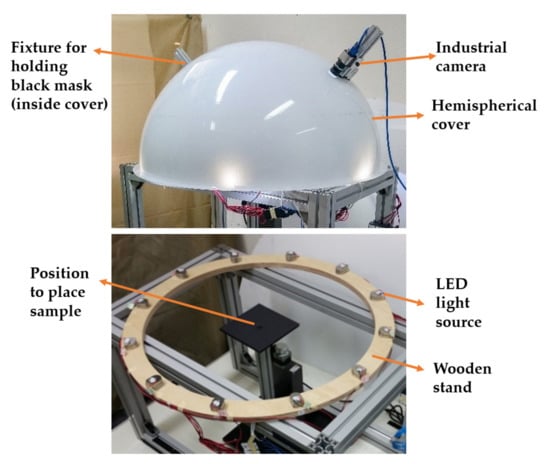
Figure 1.
Schematic of the hardware framework.
2. Experimental Setup and Methods
The present study was conducted with two main directions. First, to reduce the high reflectivity of the object to be examined, a light source cover similar to an integrating sphere was used with the designed light source. The designed light source provided uniform illumination, which was used to capture images of the defects on specular stainless-steel plates. Second, LightTools, which is an optical simulation software from Optical Research Associates, was used to establish a light source framework similar to a hardware model. The light path in a hemispherical cover with uniform light diffusion was analyzed to verify whether the device installed in the present study had similar effectiveness to a uniform light source in an integrating sphere.
2.1. Experimental Devices: Hardware Framework
Images of the surfaces of specular stainless-steel plates were captured using a complementary metal oxide semiconductor (CMOS) camera mounted with a closed-circuit television (CCTV) lens. A USB drive was used to store the captured CMOS images. The hemispherical light source cover used in the experiment was made of acrylic and had a diameter of 800 mm. Commercial paint and matte varnishes were coated on the internal side of this cover to modulate uniform lighting effects. When LEDs were turned on, light illuminated the hemispherical surface of the light source cover. The surface characteristics of the internal coating caused the diffusion and reflection of light rays, which resulted in uniform lighting in the hemispherical cover. This lighting was similar to the uniform lighting in an integrating sphere. The uniform illumination produced in the hemispherical cover allowed the light reflection problem in the imaging of highly reflective metal products to be overcome. RainbowTM extra white paint, SdandoxTM transparent paint, and lacquer thinner with ratio 6:3:1 were mixed as the coating material inside the hemispherical cover.
2.2. Light Sources and Illumination Methods
The most crucial part of computer vision processing is the selection of a lighting method and light source. The lighting method affects whether the objects to be examined can be easily filmed; this in turn reduces the complexity of subsequent image processing. Light sources are selected on the basis of several considerations, including high contrast, object feature enhancement, a high signal-to-noise ratio, and minimum system complexity.
To lower the effect of high metal reflectivity on defect detection performance, this study constructed a defect detection environment similar to an integrating sphere. The light rays passing through the inlet of the sphere hit the internal wall of the sphere and diffused. The aim was to achieve diffused light with consistent intensity in all directions and without halation. To achieve nearly 100% diffuse reflection, multiple layers of diffusion materials were coated on the internal wall. Light rays were emitted after passing through the hemispherical cover, which was also used as an intensity attenuator. The diffusion materials had a relatively flat reflectivity spectrum in the visible-light and near-infrared ranges, and their reflectance was 90% or higher [15]. The present study adopted circular light sources as the uniform light sources.
In order to enhance the signal-to-noise ratio of defects such as dents, bulges, scratches, and gouges on stainless steel surfaces, a directional dark field is created by attaching a black mask on a suitable position of the inner surface of the hemispherical cover, while on the other side an observation camera is installed to meet the requirement whereby the angle of incidence equals the angle of reflection. In this study, the angle is set to 45 degrees for easy installation, as shown in Figure 2.
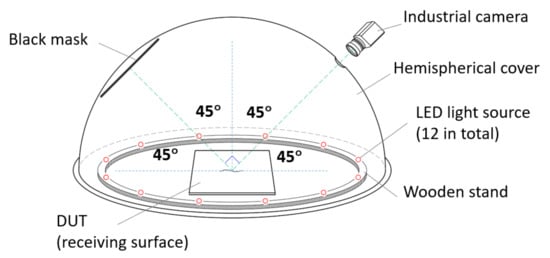
Figure 2.
Schematic of the uniform lighting system.
As illustrated in Figure 1 and Figure 2, a self-developed LED circular light source was used to generate uniform light including a hemispherical cover and 12 LEDs mounted at 30° intervals around the wooden stand. By controlling the switching on/off LEDs, a uniform lighting effect such as that observed in an integrating sphere was achieved in the hemispherical cover. The emitting angle of the LEDs could be adjusted to three angles (0 degree, 45 degrees, and 90 degrees) according to requirements as shown in Figure 3. The wooden stand is a ring with an inner diameter of 650 mm and an outer diameter of 700 mm. Figure 4 depicts the wooden stand and the naming number of each LED.
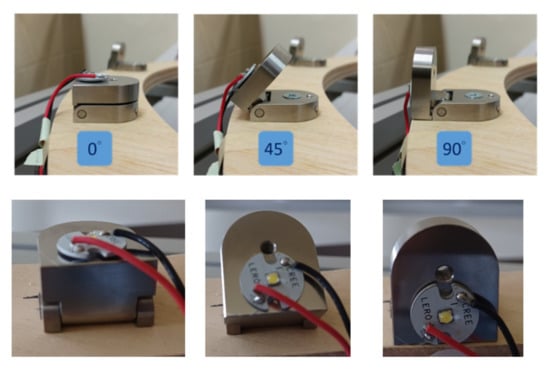
Figure 3.
Light-emitting diode (LED) with three adjustable angles of 0, 45, and 90 degrees. 0°: LED angle is 0° while emitting light rays in vertical direction. 45°: LED angle is 45° while emitting light rays in tilt 45° direction. 90°: LED angle is 90° while emitting light rays in horizontal direction.
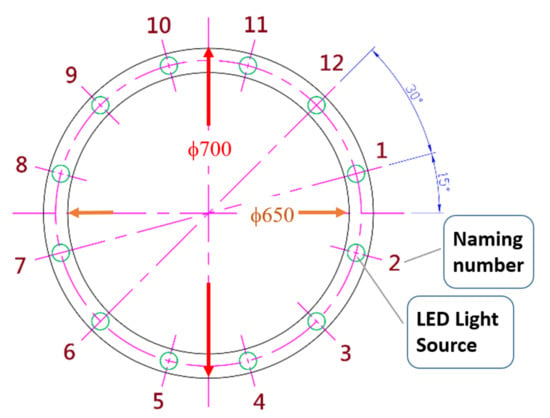
Figure 4.
Schematic of light source installation.
Controlling the light source was crucial in the present study, which mainly explored the relationship between light source positions and the features of the defects of stainless-steel plates. The illumination caused by the light source might affect the internal light source in the hemisphere and the camera imaging quality. Exceedingly high illumination may cause overexposure when capturing an image of a stainless-steel plate. Alternatively, inadequate illumination can lead to poor imaging quality, and the inspection system developed in this study might be unable to identify the defects on stainless-steel plates. The uniform light source developed in this study can illuminate defect features on specular stainless-steel plates. Thus, controlling the light source is essential.
- (1)
- Interface for controlling the light source
In this study, the light source was controlled through a human–machine interface developed using Visual Studio C#. It was used to control the operation of Arduino, an open-source electrical platform for hardware and software. This interface was comprised of six parts, as shown in Figure 5: I (sensor connection setting), II (data transmission and return), III (LED light source switch), IV (current light source state), V (value of the current light source state), and VI (historical records of the current light source state). Parts I, II, and III were the three main operations blocks, and parts IV, V, and VI displayed the values transmitted to the sensor and the current LED light source states.

Figure 5.
Interface for controlling the light source.
- (2)
- Illumination control mode
The experiment conducted in this study consisted of five basic illumination control modes, as shown in Figure 6.
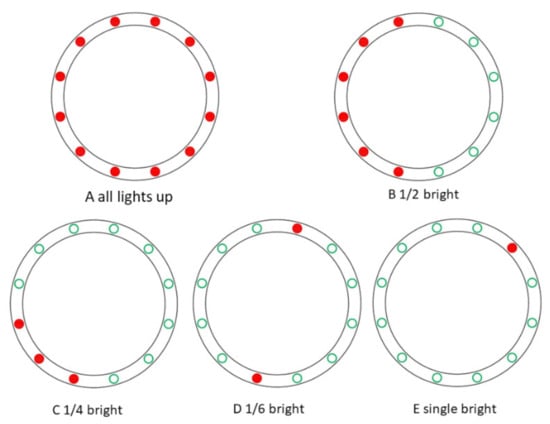
Figure 6.
Schematic of the five basic illumination control modes.
- A.
- All lights on: all the 12 LEDs were switched on for imaging.
- B.
- 1/2 bright: two groups of six LEDs were switched on separately for individual imaging.
- C.
- 1/4 bright: The 12 LEDs were divided into four groups of three consecutive LEDs each. Each LED group was switched on separately to capture images.
- D.
- 1/6 bright: The 12 LEDs were divided into six groups of two diagonal LEDs each. Each LED group was switched on separately to capture images.
- E.
- Single light on: the LEDs were separately turned on in sequence to capture images.
For each basic control mode, there could be several illumination cases depending on which LED turned on and depending on its position. For mode A, there is only one possibility, A1, since all 12 LEDs turn on. For mode B, there are two possibilities, B1 and B2, since one half of LEDs turn on either in the black mask side or camera side. For mode C, there are four possibilities: C1–4. For mode D, there are six possibilities: D1–D6. For mode E, there are twelve possibilities: D1–D12. Therefore, there are in total 25 combinations of LED states, named as light modes A1–D6, as shown in Figure 7.
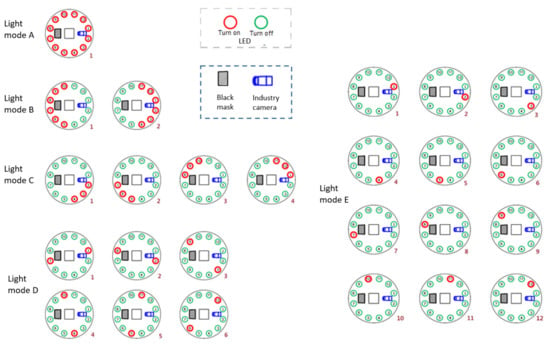
Figure 7.
Twenty-five light modes.
- (3)
- Illumination Simulation with LightTools
This study used the LightTools optical simulation software to establish a light source framework resembling the hardware model. The light path in the hemispherical cover under uniform light diffusion was analyzed. The simulation setting was employed to verify whether the installed device exhibited similar effectiveness to a uniform light source located inside an integrating sphere. The camera was installed 45° to the right of the hemisphere, as displayed in Figure 8. A dark field was installed 45° to the left of the hemisphere. The inside of the hemisphere contained 12 LEDs, and its coating parameter was set as Lambertian reflectance. Corresponding to the objective of this study, the object to be examined was set as the surface of a uniformly illuminated specular steel plate (200 mm × 200 mm).
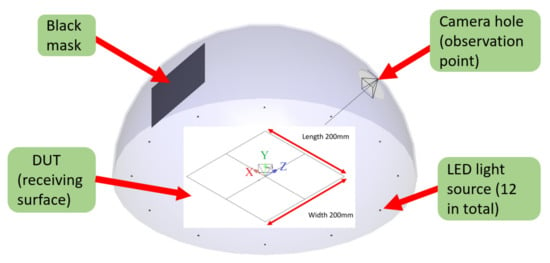
Figure 8.
Illumination simulation setting with LightTools and the receiving surface inside the hemisphere.
LightTools was combined with Visual Basic for Applications to write adjustable settings for multiple groups of parameters, including the framework model, light source, and light source angle. The most crucial information was the simulated light source uniformity and uniform light source illumination display. Simulation was conducted to optimize the effectiveness of defect detection and facilitate parameter collection and analysis. After the required parameters were set, the illumination result of the surface to be examined and the uniform light source in the hemisphere could be obtained. Subsequently, the simulation parameter adjustments and results could be displayed to rapidly identify the obtained simulation results. The implemented methods are detailed as follows.
The receiving surface, center coordinates, and length and width parameters of the object to be examined were set, and the light source was established. The light source was a circular array that contained 12 LEDs. All the LEDs, the angle of the first LED, and coordinate Y were set to “Add Pickup.” After the simulation settings were finalized, the angles of the LEDs could be changed concurrently to conform to the configuration required in this study for the light source. Programming was conducted to set the mesh size of the receiving surface, and the number of required light rays was input. Table 1 presents the analysis results obtained using LightTools under three different numbers of light rays and the illuminance distribution. From Table 1, the higher the number of light rays simulated, the more accurate the results. For example, when the number of light rays is 10,000,000, the error estimate at peak is reduced within 1.38% where the maximum illumination is 2819.9 Lux.

Table 1.
Simulation results obtained under different numbers of light rays (mesh: 10 × 10).
3. Image Processing System for Defect Detection
Digital image processing involves the use of computer programs to process images. Each image is composed of elements with specific positions and values called “pixels.” The purpose of image processing is to remove signal noise and enhance image features using commonly adopted methods, such as grayscaling, binarization, dilation, erosion, opening, closing, and edge detection.
3.1. Software Tools
- (1)
- Visual Studio (C Sharp)
In this study, the Visual C Sharp (or C#) language developed by the Microsoft Corporation was used to create a human–machine interface. C# is an advanced object-oriented programming language based on the .NET framework, and it boasts powerful Windows program development capabilities. C# development tools, which are based on the .NET Framework Class Library, feature an integrated development environment and provide numerous useful method libraries. By calling on methods from the library, commonly used functions in software development can be implemented.
- (2)
- Emgu CV
Emgu CV is a cross-platform image processing function library that uses .NET to package the Open-Source Computer Vision Library (OpenCV). Emgu CV contains a set of image and video analysis methods that involve the use of open programming source codes. The application programming interface functions of these languages can be accessed online and applied in different research fields. OpenCV can be used to develop real-time image processing, computer vision, and pattern identification programs.
3.2. Camera Parameter Adjustment
This study used a CMOS industrial camera to capture images of defects. The camera’s default parameters were the optimized parameters set by the manufacturer. Because images of metal plates with high brightness were captured in this study, all automatic adjustment functions were turned off to facilitate the use of self-defined parameters. The camera was set with a fixed aperture and focal length when capturing images. Parameters such as the pixel clock, frame rate, and exposure time were set to the optimal settings for obtaining images of defects.
Image adjustment mainly involved the adjustment of the main gain functions to enhance the brightness of the overall image. The experiment involved using a signal enhancement method to increase the brightness, which led to the amplification of many signal noises. Because the experiment focused on defect feature detection, the gain and automatic compensation functions were switched off.
3.3. Image Processing and Defect Searching
After RGB images of the defects were captured, image extraction and processing systems were used to transform these images into grayscale images. This was followed by gray scaling, binary thresholding, opening, closing and edge detection. Since we used a hemispherical cover for near-uniform lighting, no smoothing is needed. After binary thresholding, an opening operation can erase white noise and a closing operation can erase dark noise. Edge detection can obtain the information of defects. Subsequently, the profile searching function was applied to determine the defect location and area.
In the developed defect detection system, multiple defect images were tested. A total of 12 defect images were used for profile searching to identify defects. The center coordinates and defect area of the images were stored to reduce the image extraction duration for actual production lines. After the camera movement paths and image extraction were complete, as shown in Figure 9, the defect searching results could be displayed immediately.
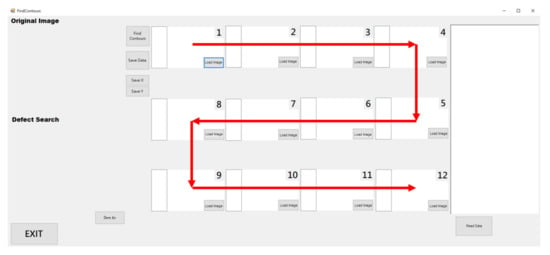
Figure 9.
Defect searching interface.
4. Results and Discussion
The results and discussion section focuses on four sub-sections: simulated light source data and experimental testing to choose a better installed angle of LED, defect detection under a directional dark field by using the proposed hemispherical cover, grayscale analyses of defects under different light source modes, and finally, optical conditions suitable for the detection of the four types of defects.
4.1. Simulated Light Source Data
LightTools was used to analyze the illumination of the developed hemispherical lampshade on the detected surface at three LED angles (0°, 45° and 90°), as shown in Figure 10, Figure 11 and Figure 12. The minimum and average illuminations were 2791.1 Lux and 2819.9 Lux, respectively, when the LED angle was 0°. The minimum and average illuminations were 1882.9 Lux and 1912.8 Lux, respectively, when the LED angle was 45°. The minimum and average illuminations were 896.6 Lux and 923.32 Lux, respectively, when the LED angle was 90°.
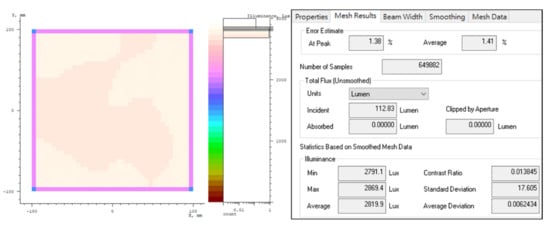
Figure 10.
Illumination diagram and simulation results for an LED angle of 0°.
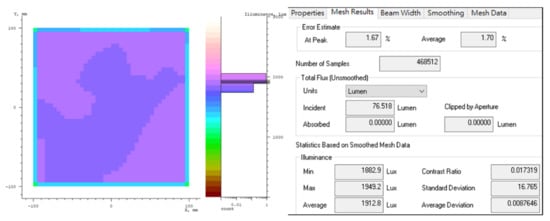
Figure 11.
Illumination diagram and simulation results for an LED angle of 45°.
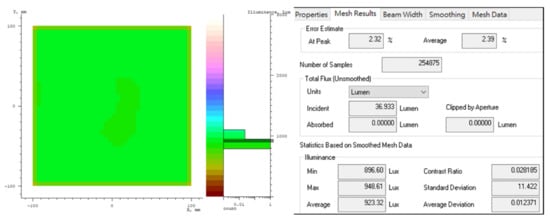
Figure 12.
Illumination diagram and simulation results for an LED angle of 90°.
To identify whether the light distribution inside the developed light source cover was uniform, this study referenced the CNS standards of lighting for indoor workplaces. Uniformity was used as the light distribution indicator in a workspace. This parameter is represented by the ratio of minimum spatial illuminance to mean spatial illuminance, as expressed in Equation (1). When the LED angles were 0°, 45°, and 90°, the uniformity in the light source cover was 0.990, 0.984, and 0.971, respectively. According to the CNS standards, the uniformity of the working surfaces should not be lower than 0.7. Thus, uniform light distribution could be achieved for the inspection structure developed in this study.
This study adopts the CNS12112 Z1044 four-point illumination calculation, and the simulated illumination results in Table 2. When the LED angle is 0°, all the LEDs emit light rays in a vertical direction until they reach the inner surface of the hemispherical cover and then reflect onto the detection surface, therefore, to produce strong illumination of about 2803–2854 Lux. The same situation occurs for the LED angle of 45°, whose illumination is about 1897–1946 Lux. When the LED angle is 90°, all the LEDs emit light rays in a horizontal direction and reflect multiple times inside the hemispherical cover to produce uniform but weak illumination of about 911–944 Lux.

Table 2.
Simulated illumination data under LED angles of 0°, 45°, and 90°.
However, the experimental investigation found that the LED angles of 0° and 45° (as depicted in Figure 13a,b) had an impact on the imaging of steel plate defects under immensely bright illumination, which caused overexposure. Since this could lead to erroneous identifications, a 90-degree LED angle was selected for this research.

Figure 13.
Images obtained under LED angles of 0°, 45°, and 90°.
4.2. Defect Detection under a Dark Field
The high reflectivity of the steel plates led to overly high brightness in the captured images; thus, image details were blurred. Consequently, this study used dark-field characteristics to obtain high-quality defect images with high detail. The aperture remained consistent during the entire sampling process, with only a black cover being added to form the dark field. Figure 14 and Figure 15 depict the scratch and bulge effects in the absence and presence, respectively, of a dark field.

Figure 14.
Scratch and bulge defects in the absence of a dark field.
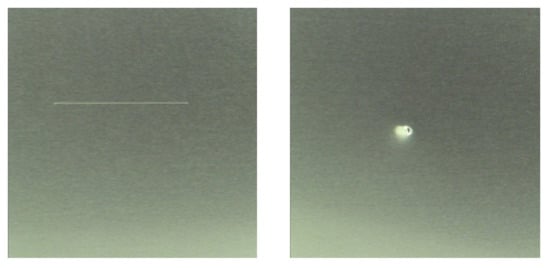
Figure 15.
Scratch and bulge defects in the presence of a dark field.
4.3. Grayscale Analyses of Defects under Different Light Modes
This study aimed to obtain the optimal lighting conditions for identifying four types of defects: dents, bulges, scratches, and gouges. Different results might be obtained for the same class of defect under different illumination control modes. In this study, five types of illumination were used: twelve LEDs, six LEDs, three LEDs, two LEDs, and one LED switched on. This involved a total of 25 combinations (modes) of LED states. For each defect type, three specimens were imaged under 25 light modes. Table 3 only lists the full-brightness images (Light mode A1) for reference.

Table 3.
The classification of four defects and specimen images under light mode A1.
The images were subjected to binary processing using the laboratory’s self-developed image processing program which was implemented to perform binary processing on the images. The threshold value was then adjusted until there was no longer any noise remaining in the image. The threshold value was then collected to produce a statistical graph. Table A1, Table A2, Table A3 and Table A4 and Figure A1, Figure A2, Figure A3 and Figure A4 represent the recorded threshold values for defects of dent, bulge, scratch, and gouge, respectively. From these results, one can find that strong lighting (mode A—twelve LEDs all switched on) has a high threshold and weak lighting (mode D or E—two LEDs or one LED switched on) has a low threshold. In between, mode B or C may be more suitable for lighting because their threshold values are near 128 (half of the highest grayscale—255).
Finally, the mean threshold values of each kind of defect are summarized in Table 4 and Figure 16 where the grayscale variations of the four types of defects are highly similar. The mean threshold values that can be treated as standards for image processing under each condition were determined and could be used to distinguish defects and the background.

Table 4.
Threshold values for four types of defects.
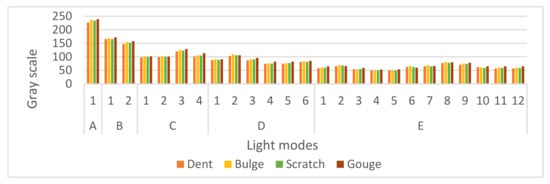
Figure 16.
Threshold chart for the four types of defects.
4.4. Illumination Conditions Suitable for the Detection of the Four Types of Defects
The grayscale values of each specimen with one of the four types of defects were transformed into signal-to-noise ratios to obtain the relationship between the signal-to-noise ratio and optimal light mode for three different specimens, as shown in Table 5. It should be noted that signal means the grayscale of the defect, while noise means the grayscale of the background. The optimal light mode was selected based on the higher frequency or maximum S/N ratio. Table 6 summarizes the optimal light mode for four types of defects which depicts that light modes A1, B1, and C2 are all suitable for the four types of defects. However, from the previous discussion, light mode A1 (12 LEDs all switched on) is not applicable due to the provision of illumination that is too strong. Therefore, based on a high S/N ratio, light mode B1 or C2 may be more suitable for defect detection. Finally, based on the image expressions in Table 7, light mode C2 had the optimal effectiveness.

Table 5.
Relationship between the signal-to-noise (S/N) ratio and the optimal light mode.

Table 6.
Optimal light mode for four types of defects.

Table 7.
Comparison between light modes B1 and C2.
5. Conclusions
This study used a hemispherical cover for the diffusion of uniform light, and various light source conditions were set to capture images of four types of defects on steel plates. An automatic optical system for defect detection was developed and used in tandem with the LightTools optical simulation software to analyze uniform light sources in the adopted hemispherical cover. Through data collection, image processing standards for various conditions were established. Eventually, the optimal light field position for image processing was identified. The conclusions of this study are as follows:
- In the conducted experiment, a dark field was set to better capture defect features because of the distinct reflectivity of dark background images. Black masks can provide dark and light fields to facilitate the detection of surfaces of metals with high reflectivity.
- In the experiment, twelve LEDs were used to illuminate twelve specimens with four types of defects (three specimens for each defect type) for imaging. Most of the threshold values were 3% lower than the means. After the data were plotted into charts, the lines representing the grayscale values for the four types of defects almost overlapped, and the threshold values for each light source mode could be determined.
- After image processing, dents and bulges were easier to identify than scratches under various light source modes. Scratches had high sensitivity to light sources and were difficult to identify under certain light source modes. Thus, the light source mode for detection should be selected mainly to highlight scratch features.
- The optimal light source mode was C2 rather than A1. C2 represents the 1/4 bright mode, in which only three LEDs were switched on at a time, whereas all twelve LEDs were switched on simultaneously in A1. Thus, the number of light sources did not determine whether defect features could be recognized clearly. The relative positions of the light sources and CCD affected recognition clarity.
- The developed system can be used to detect common defects observed on the surfaces of highly reflective metals (e.g., dents, bulges, scratches, and gouges).
Author Contributions
L.-P.H.: investigation, data curation, validation, and writing—original draft; Q.-C.H.: conceptualization, resources, writing—review and editing, and supervision; B.-H.L.: conceptualization, methodology, and software; C.-F.L.: methodology, software, and data curation; C.-H.C.: methodology, software, and data curation. All authors have read and agreed to the published version of the manuscript.
Funding
This research was partially funded by the Southern Taiwan Interdisciplinary Center for Innovative Technologies—Industrial Technology Research Institute (ITRI), Taiwan, under grant number 105A6137-2.
Data Availability Statement
Data is contained within the article.
Acknowledgments
The authors would like to acknowledge the partial financial support from the Southern Taiwan Interdisciplinary Center for Innovative Technologies—Industrial Technology Research Institute (ITRI), Taiwan. The authors would like to thank Professor Chao-Hsien Chen, Department of Mechanical Engineering, National Kaohsiung University of Science and Technology for his in-depth discussion.
Conflicts of Interest
The authors declare no conflict of interest.
Appendix A

Table A1.
Threshold values for defect of dents.
Table A1.
Threshold values for defect of dents.
| Light Modes | Threshold (Measured Value) | Average | |||
|---|---|---|---|---|---|
| Specimen 1 | Specimen 2 | Specimen 3 | |||
| A | 1 | 227 | 229 | 225 | 227 |
| B | 1 | 162 | 164 | 172 | 166 |
| 2 | 147 | 149 | 146 | 147 | |
| C | 1 | 98 | 98 | 97 | 98 |
| 2 | 98 | 98 | 100 | 99 | |
| 3 | 119 | 121 | 121 | 120 | |
| 4 | 101 | 102 | 99 | 101 | |
| D | 1 | 88 | 88 | 87 | 88 |
| 2 | 102 | 105 | 103 | 103 | |
| 3 | 91 | 85 | 86 | 87 | |
| 4 | 74 | 74 | 73 | 74 | |
| 5 | 75 | 74 | 76 | 75 | |
| 6 | 81 | 84 | 77 | 81 | |
| E | 1 | 58 | 59 | 58 | 58 |
| 2 | 65 | 68 | 64 | 66 | |
| 3 | 55 | 53 | 54 | 54 | |
| 4 | 50 | 48 | 51 | 50 | |
| 5 | 50 | 48 | 51 | 50 | |
| 6 | 63 | 63 | 62 | 63 | |
| 7 | 66 | 65 | 64 | 65 | |
| 8 | 75 | 77 | 80 | 77 | |
| 9 | 74 | 67 | 72 | 71 | |
| 10 | 58 | 58 | 69 | 62 | |
| 11 | 58 | 57 | 56 | 57 | |
| 12 | 58 | 57 | 55 | 57 | |
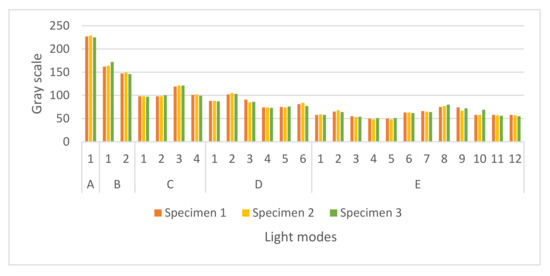
Figure A1.
Threshold chart for defect of dents.

Table A2.
Threshold values for defect of bulges.
Table A2.
Threshold values for defect of bulges.
| Light Modes | Threshold (Measured Value) | Average | |||
|---|---|---|---|---|---|
| Specimen 1 | Specimen 2 | Specimen 3 | |||
| A | 1 | 237 | 237 | 237 | 237 |
| B | 1 | 170 | 168 | 169 | 169 |
| 2 | 156 | 153 | 154 | 154 | |
| C | 1 | 102 | 102 | 104 | 103 |
| 2 | 104 | 101 | 101 | 102 | |
| 3 | 126 | 125 | 125 | 125 | |
| 4 | 107 | 105 | 106 | 106 | |
| D | 1 | 93 | 90 | 91 | 91 |
| 2 | 109 | 109 | 108 | 109 | |
| 3 | 93 | 89 | 92 | 91 | |
| 4 | 77 | 76 | 76 | 76 | |
| 5 | 76 | 76 | 76 | 76 | |
| 6 | 87 | 80 | 83 | 83 | |
| E | 1 | 62 | 60 | 60 | 61 |
| 2 | 70 | 70 | 70 | 70 | |
| 3 | 56 | 53 | 54 | 54 | |
| 4 | 52 | 49 | 50 | 50 | |
| 5 | 53 | 50 | 50 | 51 | |
| 6 | 72 | 63 | 64 | 66 | |
| 7 | 74 | 67 | 67 | 69 | |
| 8 | 81 | 80 | 81 | 81 | |
| 9 | 77 | 73 | 74 | 75 | |
| 10 | 62 | 60 | 61 | 61 | |
| 11 | 62 | 59 | 61 | 61 | |
| 12 | 61 | 59 | 59 | 60 | |
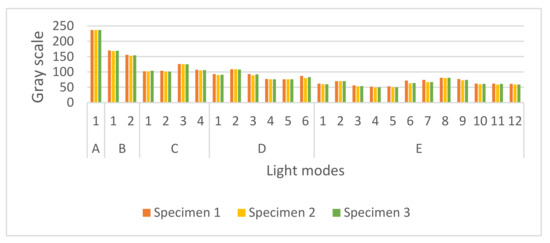
Figure A2.
Threshold chart for defect of bulges.

Table A3.
Threshold values for defect of scratches.
Table A3.
Threshold values for defect of scratches.
| Light Modes | Threshold (Measured Value) | Average | |||
|---|---|---|---|---|---|
| Specimen 1 | Specimen 2 | Specimen 3 | |||
| A | 1 | 232 | 234 | 236 | 234 |
| B | 1 | 166 | 165 | 167 | 166 |
| 2 | 151 | 151 | 154 | 152 | |
| C | 1 | 98 | 100 | 101 | 100 |
| 2 | 98 | 100 | 101 | 100 | |
| 3 | 123 | 123 | 124 | 123 | |
| 4 | 105 | 103 | 106 | 105 | |
| D | 1 | 88 | 89 | 89 | 89 |
| 2 | 106 | 106 | 107 | 106 | |
| 3 | 88 | 94 | 91 | 91 | |
| 4 | 74 | 75 | 77 | 75 | |
| 5 | 75 | 76 | 79 | 77 | |
| 6 | 80 | 82 | 82 | 81 | |
| E | 1 | 60 | 59 | 60 | 60 |
| 2 | 67 | 68 | 68 | 68 | |
| 3 | 53 | 55 | 56 | 55 | |
| 4 | 49 | 50 | 51 | 50 | |
| 5 | 49 | 50 | 50 | 50 | |
| 6 | 60 | 65 | 63 | 63 | |
| 7 | 65 | 65 | 66 | 65 | |
| 8 | 78 | 78 | 77 | 78 | |
| 9 | 72 | 76 | 73 | 74 | |
| 10 | 60 | 59 | 59 | 59 | |
| 11 | 59 | 59 | 59 | 59 | |
| 12 | 58 | 59 | 60 | 59 | |
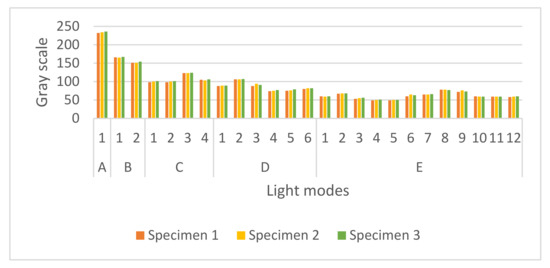
Figure A3.
Threshold chart for defect of scratches.

Table A4.
Threshold values for defect of gouges.
Table A4.
Threshold values for defect of gouges.
| Light Modes | Threshold (Measured Value) | Average | |||
|---|---|---|---|---|---|
| Specimen 1 | Specimen 2 | Specimen 3 | |||
| A | 1 | 240 | 238 | 240 | 239 |
| B | 1 | 172 | 171 | 172 | 172 |
| 2 | 158 | 158 | 159 | 158 | |
| C | 1 | 102 | 102 | 102 | 102 |
| 2 | 102 | 100 | 101 | 101 | |
| 3 | 128 | 129 | 130 | 129 | |
| 4 | 114 | 113 | 114 | 114 | |
| D | 1 | 92 | 90 | 91 | 91 |
| 2 | 106 | 104 | 108 | 106 | |
| 3 | 95 | 97 | 97 | 96 | |
| 4 | 82 | 81 | 82 | 82 | |
| 5 | 82 | 81 | 82 | 82 | |
| 6 | 86 | 85 | 85 | 85 | |
| E | 1 | 64 | 65 | 65 | 65 |
| 2 | 67 | 65 | 66 | 66 | |
| 3 | 58 | 59 | 59 | 59 | |
| 4 | 53 | 53 | 53 | 53 | |
| 5 | 54 | 55 | 53 | 54 | |
| 6 | 61 | 61 | 59 | 60 | |
| 7 | 65 | 65 | 67 | 66 | |
| 8 | 80 | 78 | 83 | 80 | |
| 9 | 76 | 81 | 77 | 78 | |
| 10 | 65 | 64 | 66 | 65 | |
| 11 | 65 | 65 | 66 | 65 | |
| 12 | 65 | 64 | 65 | 65 | |
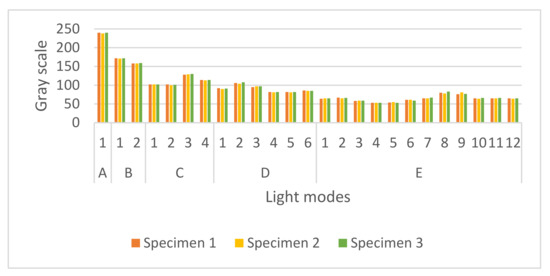
Figure A4.
Threshold chart for defect of gouges.
References
- Huang, X.Q.; Luo, X.B. A Real-time algorithm for Aluminum surface defect extraction on non-uniform image form CCD camera. In Proceedings of the 13th International Conference on Machine Learning and Cybernetics, Lanzhou, China, 13–16 July 2014. [Google Scholar]
- Wang, H.; Wang, J.; Chen, W.; Xu, L. Automatic illumination planning for robot vision inspection system. Neurocomputing 2018, 275, 19–28. [Google Scholar] [CrossRef]
- Chen, M.F.; Chen, B.C.; Chen, C.W.; Weng, R.C.; Chang, M. Design and implementation of an illumination device for optical inspection of defects in glass substrates. In Proceedings of the Ninth International Symposium on Precision Engineering Measurement and Instrumentation, Changsha/Zhangjiajie, China, 6 March 2015. [Google Scholar]
- Molina, J.; Solanes, J.E.; Arnal, L.; Tornero, J. On the detection of defects on specular car body surfaces. Rob. Comput. Integr. Manuf. 2017, 48, 263–278. [Google Scholar] [CrossRef]
- Martínez, S.S.; Vázquez, C.O.; García, J.G.; Ortega, J.G. Quality inspection of machined metal parts using an image fusion technique. Measurement 2017, 111, 374–383. [Google Scholar] [CrossRef]
- León, F.P.; Kammel, S. Inspection of specular and painted surfaces with centralized fusion techniques. Measurement 2006, 39, 536–546. [Google Scholar] [CrossRef]
- Jin, Y.; Wang, Z.; Zhu, L.; Yang, J. Research on in-line glass defect inspection technology based on dual CCFL. Procedia Eng. 2011, 15, 1797–1801. [Google Scholar] [CrossRef]
- Zhang, X.W.; Ding, Y.Q.; Lv, Y.Y.; Shi, A.Y.; Liang, R.Y. A vision inspection system for the surface defects of strongly reflected metal based on multi-class SVM. Expert Syst. Appl. 2011, 38, 5930–5939. [Google Scholar]
- Li, L.; Wang, Z.; Pei, F.; Wang, X. Improved illumination for vision-based defect inspection of highly reflective metal surface. Opt. Lett. 2013, 11, 021102. [Google Scholar]
- Huang, Y.; Wang, J.; Song, Y.; Yue, H.; Fang, Y.; Liu, Y. A novel defect detection method with eliminating dust for specular surfaces based on structured-light modulation analysis technique. Opt. Laser Technol. 2021, 141, 107089. [Google Scholar] [CrossRef]
- Kwon, N.K.; Park, C.H.; Yun, S.W.; Park, P.G. Vision based mura detection by using property of line scan camera for black resin-coated steel—Line scan algorithm. In Proceedings of the 13th International Conference on Control, Automation and Systems, Gwangju, Republic of Korea, 20–23 October 2013. [Google Scholar]
- Seulin, R.; Bonnot, N.; Merienne, F.; Gorria, P. Simulation process for the design and optimization of a machine vision system for specular surface inspection. In Proceedings of the SPIE Machine Vision and Three-Dimensional Imaging Systems for Inspection and Metrology II, Boston, MA, USA, 28–31 October 2002; Volume 4567, pp. 129–140. [Google Scholar]
- Luo, Q.; He, Y. A cost-effective and automatic surface defect inspection system for hot-rolled flat steel. Rob. Comput. Integr. Manuf. 2016, 38, 16–30. [Google Scholar] [CrossRef]
- Win, M.; Bushroa, A.R.; Hassan, M.A.; Hilman, N.M.; Ari, I.E. A contrast adjustment thresholding method for surface defect detection based on mesoscopy. IEEE Trans. Ind. Inf. 2015, 11, 642–649. [Google Scholar] [CrossRef]
- Liu, X.; Xu, K.; Zhou, D. Improvements for the recognition rate of surface defects of aluminum sheets. In Light Metals 2019; Springer: Cham, Switzerland, 2019; pp. 513–518. [Google Scholar]
- Mordia, R.; Verma, A.K. Visual techniques for defects detection in steel products A comparative study. Eng. Fail. Anal. 2022, 134, 106047. [Google Scholar] [CrossRef]
- Qiu, K.; Tian, L.; Wang, P. An effective framework of automated visual surface defect detection for metal parts. IEEE Sens. J. 2021, 21, 20412–20420. [Google Scholar] [CrossRef]
- Dawda, A.; Nguyen, M. Defects detection in highly specular surface using a combination of stereo and laser reconstruction. In Proceedings of the 35th International Conference on Image and Vision Computing, Wellington, New Zealand, 25–27 November 2020. [Google Scholar]
- Hao, Z.; Wang, Z.; Bai, D.; Zhou, S. Towards the steel plate defect detection: Multidimensional feature information extraction and fusion. Concurrency Comput. Pract. Exp. 2021, 33, e6384. [Google Scholar] [CrossRef]
- Rosati, G.; Boschetti, G.; Biondi, A.; Rossi, A. Real-time defect detection on highly reflective curved surfaces. Opt. Lasers Eng. 2009, 47, 379–384. [Google Scholar] [CrossRef]
- Jacques, S.L.; Pogue, B.W. Tutorial on diffuse light transport. J. Biomed. Opt. 2008, 13, 041302. [Google Scholar] [CrossRef] [PubMed]
Disclaimer/Publisher’s Note: The statements, opinions and data contained in all publications are solely those of the individual author(s) and contributor(s) and not of MDPI and/or the editor(s). MDPI and/or the editor(s) disclaim responsibility for any injury to people or property resulting from any ideas, methods, instructions or products referred to in the content. |
© 2023 by the authors. Licensee MDPI, Basel, Switzerland. This article is an open access article distributed under the terms and conditions of the Creative Commons Attribution (CC BY) license (https://creativecommons.org/licenses/by/4.0/).


